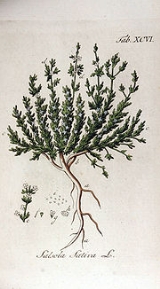
Halogeton
Encyclopedia
Halogeton is a plant genus of the family Amaranthaceae
. The genus name, Halogeton, derives from the Greek words for "salt" and for "neighbor."
papillose staminodial disk. In fruit, the tepals develop five wings.
in Spain that produced soda ash. The species was considered to be a "saltwort
" plant.
is considered a noxious weed in most regions of the United States; a particular difficulty with H. glomeratus is that it is poisonous to sheep, and possibly to cattle, due to the high concentration of sodium oxalate in the dry plant. The common names for H. glomeratus include halogeton (the same as the genus), barilla
, and saltlover.
e of some Lepidoptera
species including The Nutmeg
and the Coleophora
case-bearers C. klimeschiella and C. parthenica.
(in Ledeb., Icon. Pl. Fl. Ross. 1: 10), with the type species Halogeton glomeratus
(M. Bieb.) C.A.Mey. Synonyms are Agathophora (Fenzl) Bunge and Micropeplis Bunge.
The genus includes about 5 species:
Amaranthaceae
The flowering plant family Amaranthaceae, the Amaranth family, contains about 176 genera and 2,400 species.- Description :Most of these species are herbs or subshrubs; very few are trees or climbers. Some species are succulent....
. The genus name, Halogeton, derives from the Greek words for "salt" and for "neighbor."
Description
The genus Halogeton includes both annual and perennial species. The leaves are fleshy cylindrical, terminating in a persistent or caducous bristle. There are three to several flowers in the axil of each floral leaf. The perianth segments are membranous. The stamens are fixed on apapillose staminodial disk. In fruit, the tepals develop five wings.
Distribution and Habitat
The annual species grow in temperate salines and ruderal places, while the perennials are found in warm and hot deserts. They are tolerant of fairly saline soils.Uses
Halogeton sativus was cultivated for the enormous 18th Century barilla industryBarilla
Barilla S.p.A. is a major Italian and European food company founded in 1877 in Parma, Italy by Pietro Barilla...
in Spain that produced soda ash. The species was considered to be a "saltwort
Saltwort
Saltwort is a common name for several genera of flowering plants, including:*Batis, family Bataceae*Salicornia and Salsola, family Amaranthaceae*Salsola kali, prickly saltwort...
" plant.
Weeds
Halogeton glomeratusHalogeton glomeratus
Halogeton glomeratus is a species of flowering plant in the amaranth family known by the common names saltlover, Aral barilla, and halogeton. It is native to Russia and China, but the plant is probably better known in the western United States, where it is an introduced species and a notorious...
is considered a noxious weed in most regions of the United States; a particular difficulty with H. glomeratus is that it is poisonous to sheep, and possibly to cattle, due to the high concentration of sodium oxalate in the dry plant. The common names for H. glomeratus include halogeton (the same as the genus), barilla
Barilla
Barilla S.p.A. is a major Italian and European food company founded in 1877 in Parma, Italy by Pietro Barilla...
, and saltlover.
Ecology
Halogeton species are used as food plants by the larvaLarva
A larva is a distinct juvenile form many animals undergo before metamorphosis into adults. Animals with indirect development such as insects, amphibians, or cnidarians typically have a larval phase of their life cycle...
e of some Lepidoptera
Lepidoptera
Lepidoptera is a large order of insects that includes moths and butterflies . It is one of the most widespread and widely recognizable insect orders in the world, encompassing moths and the three superfamilies of butterflies, skipper butterflies, and moth-butterflies...
species including The Nutmeg
Nutmeg (moth)
The nutmeg , also known as the clover cutworm, is a moth of the family Noctuidae. It is found throughout Europe although in the north of its range it is a summer migrant, not being able to survive the cold winters.This is a small to medium species with cryptically coloured forewings, varying from...
and the Coleophora
Coleophora
Coleophora is a very large genus of moths of the family Coleophoridae. It contains some 1,350 described species. The genus is represented on all continents, but the majority are found in the Nearctic and Palaearctic regions...
case-bearers C. klimeschiella and C. parthenica.
Systematics
The genus Halogeton was published in 1829 by Carl Anton von MeyerCarl Anton von Meyer
Carl Anton Andreevic von Meyer was a Russian botanist and explorer.Meyer took part in expeditions, including one to the Altay Mountains with Karl Friedrich von Ledebour and Alexander G. von Bunge in 1826-27. He was the director of the botanical gardens at Saint Petersburg from 1850 to 1855.-...
(in Ledeb., Icon. Pl. Fl. Ross. 1: 10), with the type species Halogeton glomeratus
Halogeton glomeratus
Halogeton glomeratus is a species of flowering plant in the amaranth family known by the common names saltlover, Aral barilla, and halogeton. It is native to Russia and China, but the plant is probably better known in the western United States, where it is an introduced species and a notorious...
(M. Bieb.) C.A.Mey. Synonyms are Agathophora (Fenzl) Bunge and Micropeplis Bunge.
The genus includes about 5 species:
- Halogeton alopecuroides (Delile) Moq.
- Halogeton arachnoideus Moq.
- Halogeton glomeratusHalogeton glomeratusHalogeton glomeratus is a species of flowering plant in the amaranth family known by the common names saltlover, Aral barilla, and halogeton. It is native to Russia and China, but the plant is probably better known in the western United States, where it is an introduced species and a notorious...
(M. Bieb.) C. A. Mey. - Halogeton sativus (L.) Moq., Synonym Salsola sativa L.
- Halogeton tibeticus Bunge (Bunge 1862; Botschantzev 1977).

